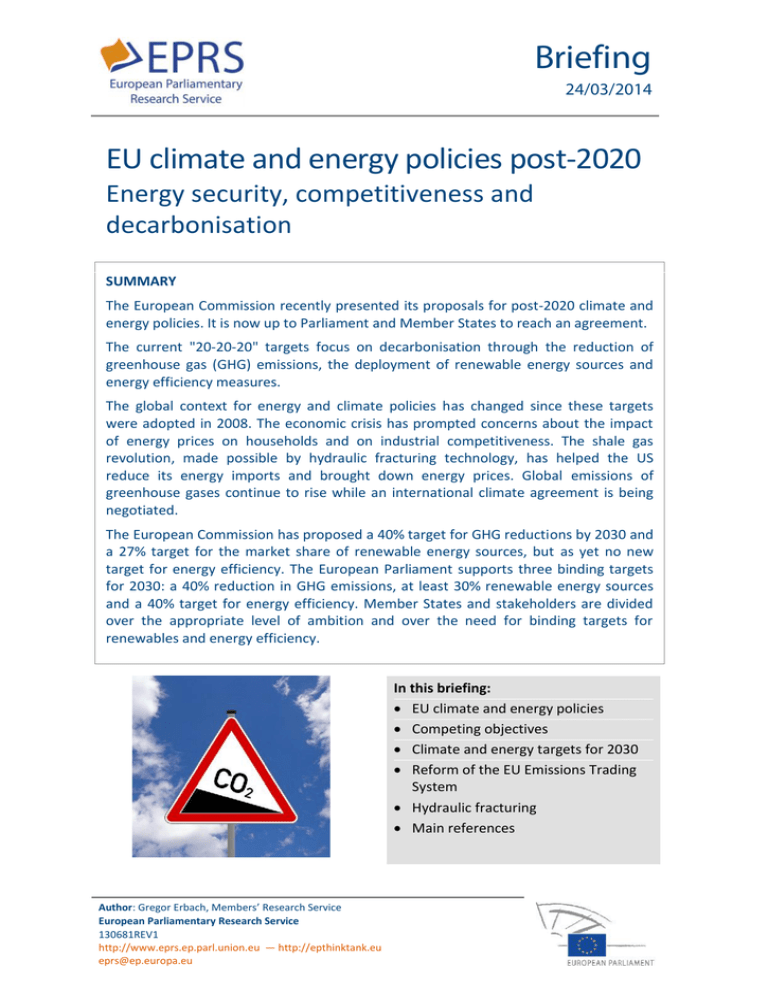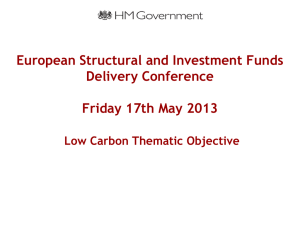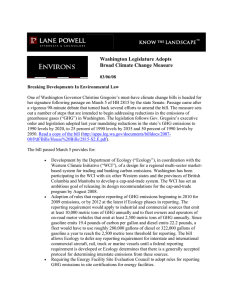
Briefing
24/03/2014
EU climate and energy policies post-2020
Energy security, competitiveness and
decarbonisation
SUMMARY
The European Commission recently presented its proposals for post-2020 climate and
energy policies. It is now up to Parliament and Member States to reach an agreement.
The current "20-20-20" targets focus on decarbonisation through the reduction of
greenhouse gas (GHG) emissions, the deployment of renewable energy sources and
energy efficiency measures.
The global context for energy and climate policies has changed since these targets
were adopted in 2008. The economic crisis has prompted concerns about the impact
of energy prices on households and on industrial competitiveness. The shale gas
revolution, made possible by hydraulic fracturing technology, has helped the US
reduce its energy imports and brought down energy prices. Global emissions of
greenhouse gases continue to rise while an international climate agreement is being
negotiated.
The European Commission has proposed a 40% target for GHG reductions by 2030 and
a 27% target for the market share of renewable energy sources, but as yet no new
target for energy efficiency. The European Parliament supports three binding targets
for 2030: a 40% reduction in GHG emissions, at least 30% renewable energy sources
and a 40% target for energy efficiency. Member States and stakeholders are divided
over the appropriate level of ambition and over the need for binding targets for
renewables and energy efficiency.
In this briefing:
EU climate and energy policies
Competing objectives
Climate and energy targets for 2030
Reform of the EU Emissions Trading
System
Hydraulic fracturing
Main references
Author: Gregor Erbach, Members’ Research Service
European Parliamentary Research Service
130681REV1
http://www.eprs.ep.parl.union.eu — http://epthinktank.eu
eprs@ep.europa.eu
EU climate and energy policies post-2020
EU climate and energy policies
Europe is in the midst of a debate about medium-term (2020-30) climate and energy
policies that would promote cost-efficient decarbonisation, and provide certainty for
investments in long-lived energy infrastructure. The European Commission (EC) has
proposed a policy framework, centred around a core target for reducing GHG emissions,
whereas the European Parliament (EP) favours separate targets for GHG reductions,
renewable energy and energy efficiency.
Targets for 2020
The EU's current climate and energy policies, part of the Europe 2020 strategy, are
focused on preventing dangerous climate change by reducing emissions of greenhouse
gases (GHG). The targets for 2020 are a 20% reduction in GHG emissions compared to
1990, a 20% market share for renewable energy sources, and a 20% improvement in
energy efficiency. These so-called "20-20-20" targets were agreed by EU leaders in 2007
and enacted through legislation set out in the 2009 climate and energy package .
The 20-20-20 targets have so far had mixed results. With an 18% reduction in GHG
emissions by 2012, the EU is likely to achieve its 20% target for 2020. In 2011, 13% of
final energy consumption came from renewable sources. While some Member States
(MS) are on track to achieve their targets for the market share of renewables, others
will have to make additional efforts. Only a 17% improvement in energy efficiency is
expected from measures under the 2012 Energy Efficiency Directive.
Objectives for 2050
In 2009, the European Council agreed the long-term objective of reducing EU GHG
emissions by 80-95% by 2050, compared to 1990 levels, in the context of similar
reductions by other developed countries. To outline the path towards such a lowcarbon future, the EC presented roadmaps for a competitive low-carbon economy,
resource efficiency, energy and transport.
Policies for 2030
In order to bridge the gap between the targets for 2020 and long-term objectives for
2050, the EC adopted a Communication on 22 January 2014 on a policy framework for
climate and energy in the period from 2020 to 2030. It proposes a binding GHG
reduction target of 40% and a binding target of 27% for the market share of renewable
energy sources, but so far no energy efficiency target. It is accompanied by a legislative
proposal for reforming the EU Emissions Trading System (ETS), a Recommendation on
hydraulic fracturing (fracking), as well as a report about energy prices and costs. The EC
did not, however, propose renewal of the Fuel Quality Directive, which will end in 2020.
On 5 February 2014, the European Parliament (EP) voted in favour of three binding
targets for emissions reductions, renewable energy sources and energy efficiency,
referring to the Commission's proposal as “short-sighted and unambitious”.
The European Council of 20-21 March 2014 called on Council and EC to analyse the
implications of the EC proposals on individual MS, to review the Energy Efficiency
Directive and to develop an energy efficiency framework. It aims to take a final decision
on the new policy framework no later than October 2014, in good time to submit the
EU's offer for the international climate negotiations by early 2015. It also called on the
EC to present, by June 2014, a comprehensive plan for reducing EU energy dependence.
Members’ Research Service
130681REV1
24/03/2014
Page 2 of 8
EU climate and energy policies post-2020
Competing objectives
The challenge for climate and energy policies is to balance three objectives: security of
energy supply, competitive energy prices, and decarbonisation.
Security of supply
The EU is heavily dependent on energy imports – more than half of its energy
consumption comes from imports. Two-thirds of the natural gas consumed and 85% of
oil are imported. Security of energy supply is thus an important concern, in particular
for Member States (MS) that have few indigenous energy sources and depend on a
single supplier for most of their energy needs.
Security of supply can be achieved by different means. Diversification of imports can
reduce dependence on individual suppliers, and supply contracts can ensure deliveries
at competitive prices. Energy infrastructure, such as oil and gas pipelines and electricity
transmission grids, may have to be constructed or upgraded in order to diversify supply
and create cross-border connections.
Indigenous energy sources help to reduce dependence on imports. These include
conventional (coal, gas, oil) and unconventional (shale gas and shale oil) fossil fuels and
renewable energy sources (hydropower, solar, wind, and biofuels). However, as
sunshine and wind are not always available, a growing share of solar and wind power
poses challenges for the stability of electricity supply, which need to be addressed
through back-up generation capacity, energy storage and better grid interconnections.
Gas-powered and nuclear electricity generation are other options for ensuring a stable
electricity supply while reducing emissions, compared to coal.
The US has been able to reduce its dependency on imports by increasing its own gas
and oil production through the application of hydraulic fracturing. In Europe, further
exploration is needed to assess the potential of fracking for energy production.
Competitiveness
Falling gas and electricity prices, made possible by the ‘shale revolution’, have made the
US an attractive location for energy-intensive industries. There is concern – exacerbated
by the economic crisis – that higher energy prices in the EU could damage the
competiveness of European industry and discourage industrial investments in the EU.
The EC released a Communication and report on energy prices and costs that shows
higher energy costs in the EU than in many other regions, and a widening gap. Inside the
EU, there are significant differences in energy prices between MS and industrial sectors.
Rises in electricity prices are driven mostly by taxes and levies, and network costs.
Separate national support schemes for renewables and fragmented European energy
markets are considered to contribute to high energy prices. IHS warns that rising prices
for energy from renewable sources (RES) could endanger German industrial competitiveness. Completion of the internal energy market, due in 2014, should lead to lower prices.
Decarbonisation
With no universal climate commitment, global CO2 emissions have risen 36% since
2000, reaching 34.5 billion tonnes in 2012. If GHG emissions grow at this rate for the
next two decades, the internationally agreed target of limiting global warming to below
2°C is likely to be missed.
Members’ Research Service
130681REV1
24/03/2014
Page 3 of 8
EU climate and energy policies post-2020
Falling emissions in Europe and the US are more than compensated by rapidly rising
emissions in other parts of the world, notably in Asia. China's per capita emissions are
now almost as high as the EU's. However, reduction commitments under the Kyoto
protocol apply only to developed countries. Moreover, for the 2013-20 period,
commitments were made only by the EU, other European states and Australia. As the
EU accounts for only 11% (and falling) of global GHG emissions, EU action alone can
have only a limited impact on global climate change.
An international climate agreement – applicable to all countries – is due to be
concluded in 2015 and come into force in 2020. However, the outcome is far from
certain, as developed and developing countries disagree about their respective
responsibilities, and Canada, Australia and Japan have recently lowered their ambition
to reduce GHG emissions. UN Secretary-General Ban Ki-moon has invited heads of state
and government, along with stakeholders, to a Climate Summit in September 2014.
Apart from reducing climate change, decarbonisation is considered to bring further
benefits such as less pollution, technology leadership, ‘green’ jobs and reduced
dependence on energy imports (for countries without primary energy sources).
Climate and energy targets for 2030
Opinions are divided over whether decarbonisation can be best achieved with a single
GHG reduction target, or if additional targets for renewable energy sources (RES) and
energy efficiency are needed.
Proponents of a single "technology neutral" target consider that this is enough to set
the path for decarbonisation, and that it should be left to the markets to achieve in the
most cost-effective way. They contend that dedicated support for renewable energy
sources and energy efficiency will lead to distortions and non-cost-effective outcomes.
Others argue that separate targets for RES and energy efficiency are needed to
overcome market failures. They see the RES and energy efficiency sectors as drivers for
growth, innovation and employment.
Cuts in greenhouse gas emissions
Current EU policy
There are two mechanisms for achieving the 2020 target of reducing GHG emissions by
20% compared to 1990 levels: an EU-wide cap on GHG emissions under the Emissions
Trading System (ETS), and national targets for sectors not covered by the ETS. The ETS
applies to more than 11 000 power stations and industrial plants, as well as aviation. For
the non-ETS sectors (such as transport, buildings, agriculture and waste), national
targets are set in the Effort Sharing Decision.
By 2012, the EU had reduced its GHG emissions by 18%, compared to 1990. The 20%
target for 2020 is thus likely to be achieved. In the non-ETS sector, 15 MS emitted less
than their national target for 2020.
Commission proposal
The EC proposes a 40% reduction in GHG emissions by 2030, compared to 1990 levels.
This reduction is to be achieved by reducing the annual number of emissions allowances
in the ETS, and by national targets for the non-ETS sectors.
In order to coordinate national policies, a new governance structure is proposed.
Member States would draw up national plans, which would be assessed by the EC.
Members’ Research Service
130681REV1
24/03/2014
Page 4 of 8
EU climate and energy policies post-2020
European Parliament
The EP calls for a GHG reduction of at least 40%, complemented by binding national
targets for energy efficiency and renewable energy sources.
Member States
Most of the MS that responded to the EC's public consultation favour a GHG reduction
target, although some want to make it conditional on the outcome of the international
climate negotiations. The Green Growth Group – energy, climate and environment
ministers from 13 MS – calls for an "ambitious target-based post-2020 policy
framework" and for a reform of the ETS. Poland opposes an EU target before the
conclusion of an international climate agreement, arguing that unilateral commitments
weaken the EU's negotiating position.
A number of MS, including the UK and the Czech Republic, favour a single target for
GHG reductions. The UK had proposed a unilateral EU target of 40%, which could be
raised to 50%, conditional on a comprehensive global agreement. Poland and the Czech
Republic want technology-neutral policies, where the ETS is the main instrument.
Denmark prefers to continue with the current system of three EU-wide targets.
Experts and stakeholders
Business Europe supports a single target for GHG emissions, which should take into
account the outcome of the international climate negotiations in 2015. Eurelectric
supports a single technology-neutral GHG reduction target of at least 40%. Cefic
(chemical industry) considers the proposed targets too demanding and warns of deindustrialisation. Europia (petroleum industry) worries that overlapping targets and
unilateral EU ambition could have a negative impact on the European refining industry.
The Committee of the Regions advocates three binding targets – including a 50% GHG
reduction – and points out the crucial role of local and regional authorities in the
implementation of policies. Energy Cities, an association of over 1 000 European cities,
expresses similar views.
Environmental groups (Climate Action Network, Greenpeace, WWF) call for binding
targets for GHG reduction (55%), RES (45%) and energy efficiency (40%).
Economists warn that interactions between multiple targets, at EU or national level, are
likely to reduce the effectiveness of the ETS, and lead to higher costs and higher
emissions. German think tank CEP argues that the EC should adjust its roadmaps to take
into account the possibility that climate negotiations might fail. The European Policy
Centre (EPC) welcomes the fact that the 40% target "provides direction without
dictating the means", and calls for a single market for renewable energy, as well as
concrete measures to promote energy efficiency.
Regarding international climate negotiations, some argue that the EU needs a credible
climate policy if it wants to negotiate a global agreement, while others fear that setting
a target too early will weaken the EU's negotiating position.
Targets for renewable energy sources
Current policy
The Renewable Energy Directive, adopted in 2009 as part of the climate and energy
package, sets an EU-wide target to achieve a 20% share of renewable energy sources
(RES) in gross final energy consumption by 2020. This target is broken down into binding
national targets for the MS, taking into account their wealth and resource base.
Members’ Research Service
130681REV1
24/03/2014
Page 5 of 8
EU climate and energy policies post-2020
By 2011, RES had reached a share of 13% of final energy consumption. Estonia has
already met its national target, while France and the UK were farthest away and would
have to make additional efforts to meet their respective targets.
Commission proposal
The EC proposes a binding 27% target for 2030. However, this target would be binding
only at EU level. Without national targets, MS would remain free to determine their
energy mix, and opt for other low-carbon energy sources such as nuclear.
European Parliament
In its resolution of 5 February 2014, the EP calls for an RES target of at least 30%, to be
implemented by national targets.
In response to the EC's communication on renewable energy beyond 2020, the EP
resolution of 21 May 2013 called for targets and milestones for the post-2020 period
and for an RES share above 30%.
Member States
Ministers from eight MS, including France and Germany, have called for a separate RES
target.
Experts and stakeholders
A group of 92 European companies supports mutually reinforcing targets, including a
binding target for RES. The European Renewable Energy Council, representing Europe's
renewable energy companies, favours a binding 45% target for renewable energies.
Some regard the target as lacking ambition, since a 27% RES share is considered
necessary for achieving the 40% GHG reduction, according to the EC.
Analysts point out that there is a potential conflict between market liberalisation and
climate-related state interventions in the energy market, which affect the energy mix
and are therefore the responsibility of the Member States.
Energy efficiency targets
Current policy
The Europe 2020 strategy sets a non-binding target of a 20% increase in energy
efficiency. In practice this means a 20% reduction of primary energy consumption
compared to the hypothetical projected consumption for 2020, or a 13.5% reduction
compared to 2005.
The Energy Efficiency Directive, which came into force in December 2012, sets out
measures that Member States have to take to improve their energy efficiency. These
include the renovation of public buildings, energy audits for large companies and an
obligation for energy utilities to help customers reduce their energy use.
MS set their own indicative national targets. They have until April 2014 to submit action
plans and until June 2014 to implement the provisions of the Directive.
The measures set out in the Directive are expected to result in a 17% efficiency
improvement by 2020. Additional efforts would be needed to reach the non-binding
20% target.
Commission approach
The EC plans an assessment of the Energy Efficiency Directive in the summer of 2014
and therefore chose not to propose new targets before the review was carried out.
Members’ Research Service
130681REV1
24/03/2014
Page 6 of 8
EU climate and energy policies post-2020
European Parliament
The EP resolution of 5 February 2014 calls for a binding energy efficiency target of 40%,
which should be implemented by means of individual national targets.
Research findings
Research carried out for the Coalition for Energy Savings found that the EU has a
potential for 41% cost-effective end-use energy savings by 2030, which would help
reduce GHG emissions by 49-61% and boost competitiveness and employment.
Reform of the Emissions Trading System
Current situation
The EU Emissions Trading System (ETS) is suffering from an oversupply of GHG
emissions allowances, largely due to the economic crisis – and to a lesser degree the
displacement of fossil fuels by renewables. Although the ETS achieves its goal of limiting
GHG emissions, the current price of emission allowances is too low to incentivise the
substitution of gas for coal, or investment in low-carbon technologies such as RES or
carbon capture and storage. A decision to postpone the auctioning of allowances
(backloading) has had little effect on their price.
Commission proposal
The EC put forward a legislative proposal to introduce a market stability reserve to the
ETS, in order to avoid excessive supply or shortages of allowances. Starting from 2021,
allowances would be placed in a reserve if the number of allowances in circulation
exceeds 833 million. Allowances from the reserve would be released when there are
fewer than 400 million allowances in circulation. The mechanism would be completely
automatic and predictable, without the need for any political decisions.
European Parliament
The EP supports a structural reform of the ETS, insisting that it must remain fully
market-based. The EP calls on the EC and MS to encourage the deployment of carbon
capture and storage technologies.
Reactions and Positions
Research suggests that the proposed stability reserve could lead to greater fluctuation
in the carbon price and become a source of instability. Industry analysts warn that state
support for renewables may weaken the ETS.
Hydraulic fracturing
Current policy
At present, there are no EU-wide rules on hydraulic fracturing ("fracking"). MS have
divergent approaches: some are keen to use fracking technology to explore and exploit
indigenous shale gas reserves, whereas others have banned fracking on their territory.
Commission Recommendation
The EC adopted a non-binding Recommendation concerning the use of hydraulic
fracturing for the exploration or production of shale gas/oil. The Recommendation
mostly concerns environmental aspects of hydraulic fracturing, which can have crossborder impacts. The public should be informed about any chemicals used in the process.
MS remain free to choose their approach to shale gas: they may go ahead with
exploration or choose to ban fracking.
Members’ Research Service
130681REV1
24/03/2014
Page 7 of 8
EU climate and energy policies post-2020
MS that decide to use fracking are invited to apply the recommendation by July 2014,
and report annually to the Commission. The EC will review national measures within 18
months, and decide if the voluntary approach is working or if EU legislation is needed.
European Parliament
The EC Recommendation is broadly in line with the EP resolutions of 21 November 2012
on the industrial and environmental aspects of shale gas and oil. Despite EP requests, a
new environmental impact assessment Directive will not mandate environmental
impact assessments for exploration and extraction of shale gas.
Experts and stakeholders
The climate impact of shale gas can vary according to different circumstances: if it is an
additional energy source or displaces RES, an increase in GHG emissions will result.
Climate scientists warn that the development of shale gas, a fossil fuel, is incompatible
with international commitments on climate change. If, on the other hand, shale gas
were to replace more polluting fuels such as coal, it could lead to a cost-effective
reduction in GHG emissions.
Main references
Smarter, greener, more inclusive? — Indicators to support the Europe 2020 strategy, Eurostat,
October 2013
Trends and projections in Europe 2013: Tracking progress towards Europe's climate and energy
targets until 2020, European Environment Agency, October 2013
EU policy options for climate and energy beyond 2020, PBL and Ecofys, May 2013
A new wave of European climate and energy policy: towards a 2030 framework, Gina Hanrahan,
Institute of International and European Affairs, 2013
Updating the EU’s Energy and Climate Policy: New Targets for the Post-2020 Period, Severin
Fischer / Oliver Geden, Friedrich-Ebert-Stiftung, May 2013
Why Europe’s energy and climate policies are coming apart / David Buchan, Oxford Institute for
Energy Studies, July 2013
Disclaimer and Copyright
This briefing is a summary of published information and does not necessarily represent the views of the author or the
European Parliament. The document is exclusively addressed to the Members and staff of the European Parliament
for their parliamentary work. Links to information sources within this document may be inaccessible from locations
outside the European Parliament network. © European Union, 2014. All rights reserved.
Photo credits: © FM2 / Fotolia.
http://www.eprs.ep.parl.union.eu
http://epthinktank.eu
eprs@ep.europa.eu
Members’ Research Service
130681REV1
24/03/2014
Page 8 of 8







